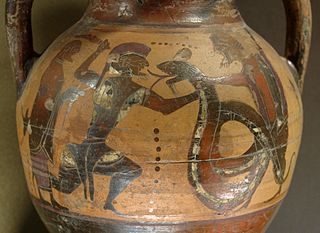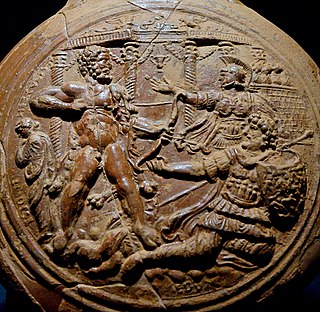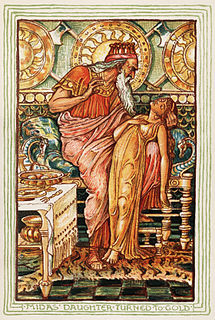 W
WIn Greek mythology, Achilles or Achilleus was a hero of the Trojan War, the greatest of all the Greek warriors, and is the central character of Homer's Iliad. He was the son of the Nereid Thetis and Peleus, king of Phthia.
 W
WIn Greek mythology, Admetus was a king of Pherae in Thessaly.
 W
WAdonis was the mortal lover of the goddess Aphrodite in Greek mythology. In Ovid's first-century AD telling of the myth, he was conceived after Aphrodite cursed his mother Myrrha to lust after her own father, King Cinyras of Cyprus. Myrrha had sex with her father in complete darkness for nine nights, but he discovered her identity and chased her with a sword. The gods transformed her into a myrrh tree and, in the form of a tree, she gave birth to Adonis. Aphrodite found the infant and gave him to be raised by Persephone, the queen of the Underworld. Adonis grew into an astonishingly handsome young man, causing Aphrodite and Persephone to feud over him, with Zeus eventually decreeing that Adonis would spend one third of the year in the Underworld with Persephone, one third of the year with Aphrodite, and the final third of the year with whomever he chose. Adonis chose to spend his final third of the year with Aphrodite.
 W
WIn Greek mythology, the Aloadae or Aloads were Otus or Otos and Ephialtes, sons of Iphimedia, wife of Aloeus, by Poseidon, whom she induced to make her pregnant by going to the seashore and disporting herself in the surf or scooping seawater into her bosom. From Aloeus they received their patronymic, the Aloadae. They were strong and aggressive giants, growing by nine fingers every month nine fathoms tall at age of nine, and only outshone in beauty by Orion.
 W
WAmphion and Zethus were, in ancient Greek mythology, the twin sons of Zeus by Antiope. They are important characters in one of the two founding myths of the city of Thebes, because they constructed the city's walls.
 W
WIn Greek mythology, Cragaleus was a son of Dryops who dwelt in the land Dryopis next to a spring which was believed to have appeared at a place where Heracles hit the earth with his club.
 W
WIn Greek mythology and later Roman mythology, the Cyclopes are giant one-eyed creatures. Three groups of Cyclopes can be distinguished. In Hesiod's Theogony, the Cyclopes are the three brothers Brontes, Steropes, and Arges, who made for Zeus his weapon the thunderbolt. In Homer's Odyssey, they are an uncivilized group of shepherds, the brethren of Polyphemus encountered by Odysseus. Cyclopes were also famous as the builders of the Cyclopean walls of Mycenae and Tiryns.
 W
WIn Greek mythology King Eurytus of Oechalia, Thessaly, was a skillful archer who even said to have instructed Heracles in his art of using the bow.
 W
WHeracles, born Alcaeus or Alcides, was a divine hero in Greek mythology, the son of Zeus and Alcmene, and the foster son of Amphitryon. He was a great-grandson and half-brother of Perseus. He was the greatest of the Greek heroes, the ancestor of royal clans who claimed to be Heracleidae (Ἡρακλεῖδαι), and a champion of the Olympian order against chthonic monsters. In Rome and the modern West, he is known as Hercules, with whom the later Roman emperors, in particular Commodus and Maximian, often identified themselves. The Romans adopted the Greek version of his life and works essentially unchanged, but added anecdotal detail of their own, some of it linking the hero with the geography of the Central Mediterranean. Details of his cult were adapted to Rome as well.
 W
WHermes is an Olympian deity in ancient Greek religion and mythology. Hermes is considered the herald of the gods. He is also considered the protector of human heralds, travellers, thieves, merchants, and orators. He is able to move quickly and freely between the worlds of the mortal and the divine, aided by his winged sandals. Hermes plays the role of the psychopomp or "soul guide"—a conductor of souls into the afterlife.
 W
WIn Greek mythology, Idas, was a Messenian prince. He was one of the Argonauts, a participant in the hunt for the Calydonian Boar and contender with the gods. Idas was described as keen and spirited.
 W
WLaocoön, the son of Acoetes, is a figure in Greek and Roman mythology and the Epic Cycle. He was a Trojan priest who was attacked, with his two sons, by giant serpents sent by the gods. The story of Laocoön has been the subject of numerous artists, both in ancient and in more contemporary times.
 W
WIn Greek mythology, Laomedon was a Trojan king, son of Ilus and thus nephew of Ganymede and Assaracus.
 W
WIn Greek mythology, the satyr Marsyas is a central figure in two stories involving music: in one, he picked up the double oboe (aulos) that had been abandoned by Athena and played it; in the other, he challenged Apollo to a contest of music and lost his hide and life. In antiquity, literary sources often emphasize the hubris of Marsyas and the justice of his punishment.
 W
WMidas is the name of one of at least three members of the royal house of Phrygia.
 W
WNestor of Gerenia was the legendary wise King of Pylos described in Homer's Odyssey. Excavations from 1939 revealed his palace, and excavations have recently resumed at the site.
 W
WIn Greek mythology, Niobe was a daughter of Tantalus and of either Dione, the most frequently cited, or of Eurythemista or Euryanassa, the wife of Amphion and the sister of Pelops and Broteas.
 W
WIn Greek mythology, the Niobids were the children of Amphion of Thebes and Niobe, slain by Apollo and Artemis because Niobe, born of the royal house of Phrygia, had boastfully compared the greater number of her own offspring with those of Leto, Apollo's and Artemis' mother: a classic example of hubris.
 W
WIn Greek mythology, Orion was a giant huntsman whom Zeus placed among the stars as the constellation of Orion.
 W
WIn Greek mythology, Phineus was a king of Salmydessus in Thrace and seer who appears in accounts of the Argonauts' voyage. Some accounts make him a king in Paphlagonia or in Arcadia.
 W
WIn Greek mythology, Python was the serpent, sometimes represented as a medieval-style dragon, living at the center of the earth, believed by the ancient Greeks to be at Delphi.
 W
WTityos or Tityus was a giant from Greek mythology.